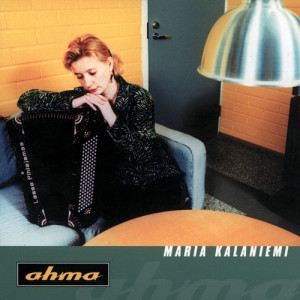 Accordion fans, take note! This one’s for you. Accordionist Maria Kalaniemi and Aldergaz play some fine tunes on this album. It seems effortlessly delivered and should be a welcome acquisition fans of the squeeze box. All others, well …
Accordion fans, take note! This one’s for you. Accordionist Maria Kalaniemi and Aldergaz play some fine tunes on this album. It seems effortlessly delivered and should be a welcome acquisition fans of the squeeze box. All others, well …
I am always amazed that these instruments are so much maligned by those who just don’t get the variety of styles being played or the richness of this instrument. There is more to the accordion than passionate Parisian ditties, raucous Celtic reels or those clunky polkas one can hear in all-night drives across Wisconsin. Now, there are references to some of these styles on Ahma, a snippet here or a reminiscent phrase there, but this is a lovely example of Finnish accordion music that is dance oriented, yet creatively produced and arranged for listening.
Years ago I had the occasion to listen to a fine accordion player many a Thursday night in my home town at a suits-meet-artists/straights-meet-gays venue. He played songs from the British Isles to the Balkans and even further afield. It was there, sipping frosties, seeing and being seen, that I really developed an appreciation for the accordion. In some ways this disc is the equivalent of those nights I remember so fondly; it is sophisticated and smooth, yet refers to familiar accordion musical traditions, translating them for a wider audience through great playing and lovely arrangements.
Fans of Celtic accordion music should like this album. The title tune in particular has a similar feel, the familiar lilt and sense of swing of much Celtic music. It’s almost as if a Celtic and a French accordionist had merged their styles to include the sweet poignancy of one and the easy syncopation of the other. I was also quite surprised to hear some riffs that were reminiscent of the furious, multi-layered sounds of Madagascar accordion wizard Regis Gisavo on a tune called “Kamppi,” although the exchange between the fiddle and accordion midway calmed things down after a fast and furious introduction. This music is dance music without the repetition needed for actually stepping out onto the floor. It is easy to imagine swinging around the dance floor to these tunes. But you don’t often hear musicians of this caliber in most local dance halls or dance tunes so easy to take on repeated listening.
The album’s great arrangements are not surprising, as most of the musicians, like Kalaniemi, also hail from the Sibelius Academy Folk Music department. Aldergaz are Timo Alakotila on piano, Olli Varis on guitars, Tarpani Varis on double bass, Petri Hakala on mandolins and Arto Järveläla on violin. These folks have a flair for the dramatic and a great sense of the potential of a tune. Slow tender numbers like “Ängskär” have just the right amount of piano backing to create a lovely sense of flow about this melody. The fast and furious songs have subtle support to keep the tension and pace going. There is also a great deal of variation in the pacing, essential for an instrumental album. Piano player Alakotila shares the composition honors with Kalaniemi for many of the tunes. There is only one “trad. arr.” number on Ahma, “Bingsjö,” another standout tune that I have to mention; it just kind of skips along brightly, with the accordion and piano taking turns in the spotlight.
Kalaniemi and company have produced a lovely album that should appeal to fans of the Scandinavian traditions as well as accordion aficionados – it certainly comes highly recommended from me.
(Northside, 2001)
